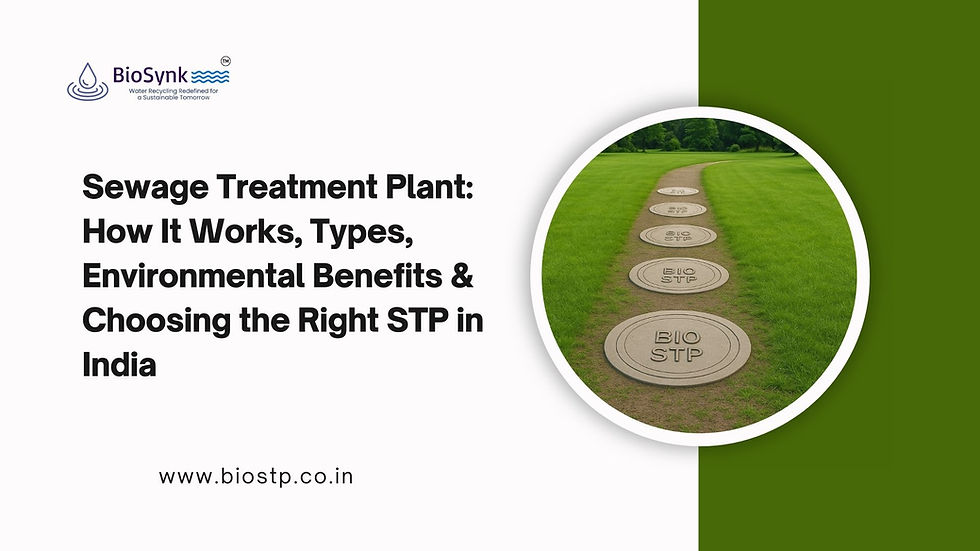Sewage Treatment Plant: How It Works, Types, Environmental Benefits & Choosing the Right STP in India
- MARKETING BIOSYNK
- Aug 14
- 4 min read

Introduction
Sewage is one of the most pressing environmental challenges facing India today. With rapid urbanization, industrial expansion, and population growth, wastewater generation has skyrocketed - but in many places, it still flows untreated into rivers, lakes, and the ground. This leads to severe water pollution, health hazards, and ecosystem damage.A Sewage Treatment Plant (STP) is the key to breaking this cycle. It removes harmful contaminants from domestic and industrial wastewater, making it safe for reuse or discharge. In this article, we’ll explore how an STP works, different types available, their environmental benefits, and how you can choose the right one in India for your needs.
1. What is a Sewage Treatment Plant (STP)?
A Sewage Treatment Plant is an engineered system designed to treat and purify wastewater before it is released back into the environment or reused. It removes physical, chemical, and biological impurities, ensuring that the treated water meets environmental safety standards set by the Central Pollution Control Board (CPCB).In India, STPs are essential for housing societies, industries, commercial complexes, and municipal bodies to comply with environmental regulations and avoid penalties.
2. How a Sewage Treatment Plant Works
While STPs can vary in design, most follow a three-stage process:
a. Primary Treatment
Removes large solids like plastics, rags, and grit using screens and grit chambers.
Sedimentation tanks allow heavier particles to settle at the bottom.
This step focuses on physical removal of impurities.
b. Secondary Treatment
Uses biological processes such as activated sludge, MBBR (Moving Bed Biofilm Reactor), or SBR (Sequencing Batch Reactor).
Microorganisms break down organic matter, reducing BOD (Biochemical Oxygen Demand) and COD (Chemical Oxygen Demand).
Aeration ensures oxygen supply for bacteria to thrive.
c. Tertiary Treatment
Involves advanced filtration and disinfection.
Technologies include sand filters, UV disinfection, and chlorination.
Produces clear, pathogen-free water suitable for reuse in gardening, flushing, and cooling towers.
3. Types of Sewage Treatment Plants in India
Different applications require different STP technologies. The main types include:
a. Activated Sludge Process (ASP)
Popular in municipal and large industrial plants.
Uses aeration tanks and settling tanks.
Low cost but requires more space and skilled operation.
b. Moving Bed Biofilm Reactor (MBBR)
Compact, energy-efficient, and suitable for smaller spaces.
Plastic carriers provide surface area for bacteria to grow.
Low maintenance and excellent for retrofitting.
c. Sequencing Batch Reactor (SBR)
Operates in batch cycles for aeration and settling.
Highly automated and produces consistent effluent quality.
Ideal for housing societies and industries.
d. Membrane Bioreactor (MBR)
Combines biological treatment with membrane filtration.
Produces ultra-clean water suitable for high-end reuse.
Higher investment cost but compact and efficient.
4. Environmental Benefits of a Sewage Treatment Plant
An STP is more than a compliance requirement - it’s a green investment:
Prevents Water Pollution: Stops raw sewage from entering rivers, lakes, and groundwater.
Protects Public Health: Removes pathogens that cause diseases like cholera, typhoid, and hepatitis.
Promotes Water Reuse: Treated water can be used for irrigation, landscaping, flushing, and industrial cooling.
Reduces Environmental Impact: Lowers harmful nutrient discharge, preventing algal blooms and aquatic death zones.
Supports Sustainable Development: Conserves freshwater and aligns with India’s water conservation goals.
5. Choosing the Right STP in India
Selecting the right STP involves considering several factors:
Capacity Requirement: Calculate the total sewage generated daily (in KLD – kilo liters per day).
Technology Type: MBBR, SBR, MBR, or ASP depending on budget, space, and quality requirements.
Regulatory Compliance: Ensure it meets CPCB and State Pollution Control Board standards.
Operational Costs: Look for energy-efficient and low-maintenance systems.
Space Availability: Choose compact designs for urban or space-limited areas.
After-Sales Support: Opt for suppliers who provide installation, operation, and maintenance services.
6. Why CPCB Compliance is Important
The Central Pollution Control Board mandates STPs for various establishments under the Water (Prevention and Control of Pollution) Act. Non-compliance can result in hefty fines, closure notices, and legal action. Installing a CPCB-approved STP ensures legal safety and protects the environment.
7. The Future of STPs in India
With increasing water scarcity and pollution concerns, the demand for eco-friendly STPs is growing. The government is pushing for zero liquid discharge (ZLD), advanced biological treatment, and smart monitoring systems. In the coming years, STPs will play a key role in achieving India’s water security and climate goals.
8. Why Choose Our Bio STP Solutions
At Bio Synk, we specialize in bio-based sewage treatment plants that are energy-efficient, low-maintenance, odor-free, and CPCB-compliant. Our innovative designs are perfect for housing complexes, industries, hospitals, and institutions. With expert installation, 24/7 support, and guaranteed performance, we make wastewater treatment hassle-free and sustainable.
9. Let’s Build a Cleaner India, Together
Every drop of wastewater treated is a step towards a cleaner river, healthier community, and greener planet. By installing a sewage treatment plant, you are not only fulfilling a legal requirement but also protecting India’s water heritage for generations to come. Let’s work together to make India’s wastewater problem a thing of the past.




Comments